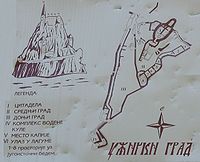
Stari Grad, Užice
Encyclopedia
Stari Grad; (Old town) is the remains of a fortress near the town of Užice
, in central Serbia
. It is an example of typical medieval Serbian architecture. Historians believe it was built between the 12th and 13th centuries to control movement along nearby roads, and the town of Užice
. It is positioned on a large steep cliff, and surrounded on three sides by the river Đetinja. Today it consists of an several ruined buildings, including the citadel and many of its surrounding walls.
 Serbian župan from 14th century, Nikola Altomanović
Serbian župan from 14th century, Nikola Altomanović
(Vojinović) ruled vast areas from Rudnik
, over Polimlje, Podrinje, east Herzegovina
with Trebinje, till Konavle and Dračevica, neighboring the Republic of Dubrovnik. He was defeated and blinded in Užice
(fortress Užice) in 1373 by a coalition of his neighbors Knez Lazar and bosnian king Tvrtko I Kotromanić, supported by the king Ludovik I of Hungary.
During next almost five hundred, the fortress was settled by Turkish army. From that period there is a great number of legends. According to the legend which describes how the Đetinja River got its name, the Ottoman Turks
in the times when they ruled these lands, once punished the local Užican people by taking their children and brutally throwing them into the river. Thus the river was named Đetinja rijeka, which in Užican dialect means the children's river.
The town was destroyed in January 1863, along with six others according to the peace treaty, signed by Mihailo Obrenović, when the Ottomans
left the fortresses.
From 2000 to 2002, there was a summer theatre stage on the top.
Užice
Užice is a city and municipality in western Serbia, located at the banks of the Đetinja river. It is the administrative center of the Zlatibor District...
, in central Serbia
Serbia
Serbia , officially the Republic of Serbia , is a landlocked country located at the crossroads of Central and Southeast Europe, covering the southern part of the Carpathian basin and the central part of the Balkans...
. It is an example of typical medieval Serbian architecture. Historians believe it was built between the 12th and 13th centuries to control movement along nearby roads, and the town of Užice
Užice
Užice is a city and municipality in western Serbia, located at the banks of the Đetinja river. It is the administrative center of the Zlatibor District...
. It is positioned on a large steep cliff, and surrounded on three sides by the river Đetinja. Today it consists of an several ruined buildings, including the citadel and many of its surrounding walls.
History

Nikola Altomanovic
Nikola Altomanović was Serbian župan from 14th century. He ruled vast areas from Rudnik, over Polimlje, Podrinje, east Herzegovina with Trebinje, till Konavle and Dračevica, neighboring the Republic of Dubrovnik...
(Vojinović) ruled vast areas from Rudnik
Rudnik
Rudnik is a mountain in central Serbia, near the town of Gornji Milanovac. Its highest peak Cvijićev vrh, named after geologist and biologist Jovan Cvijić, has an altitude of 1132 meters above sea level...
, over Polimlje, Podrinje, east Herzegovina
Herzegovina
Herzegovina is the southern region of Bosnia and Herzegovina. While there is no official border distinguishing it from the Bosnian region, it is generally accepted that the borders of the region are Croatia to the west, Montenegro to the south, the canton boundaries of the Herzegovina-Neretva...
with Trebinje, till Konavle and Dračevica, neighboring the Republic of Dubrovnik. He was defeated and blinded in Užice
Užice
Užice is a city and municipality in western Serbia, located at the banks of the Đetinja river. It is the administrative center of the Zlatibor District...
(fortress Užice) in 1373 by a coalition of his neighbors Knez Lazar and bosnian king Tvrtko I Kotromanić, supported by the king Ludovik I of Hungary.
During next almost five hundred, the fortress was settled by Turkish army. From that period there is a great number of legends. According to the legend which describes how the Đetinja River got its name, the Ottoman Turks
Ottoman Turks
The Ottoman Turks were the Turkish-speaking population of the Ottoman Empire who formed the base of the state's military and ruling classes. Reliable information about the early history of Ottoman Turks is scarce, but they take their Turkish name, Osmanlı , from the house of Osman I The Ottoman...
in the times when they ruled these lands, once punished the local Užican people by taking their children and brutally throwing them into the river. Thus the river was named Đetinja rijeka, which in Užican dialect means the children's river.
The town was destroyed in January 1863, along with six others according to the peace treaty, signed by Mihailo Obrenović, when the Ottomans
Ottoman Empire
The Ottoman EmpireIt was usually referred to as the "Ottoman Empire", the "Turkish Empire", the "Ottoman Caliphate" or more commonly "Turkey" by its contemporaries...
left the fortresses.
From 2000 to 2002, there was a summer theatre stage on the top.

